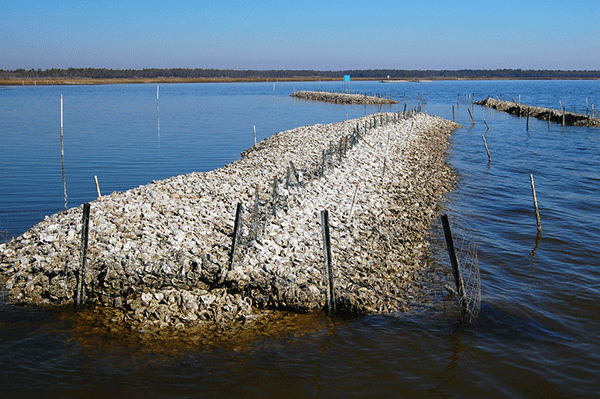
Two scientific publications this month reference research done by Dauphin Island scientists and reinstate the need of ecological restoration incorporating multiple habitats.
The studies suggest positive effects of subtidal reefs on submerged aquatic vegetation and qualitatively similar impacts of intertidal reefs on emergent marsh vegetation.
“We are long aware of oyster reefs serving as a protective shield for neighboring habitats and the water-filtering capacity of live oysters; however, this is the first time that we have observed expansion of seagrasses after artificial reef creation”, said Shailesh Sharma who is one of the authors of the study. “At this time, however, we can only suggest the increase in seagrass cover is due to the created reefs."
Sharma Sharma recently defended his dissertation at the University of South Alabama. He's joined on the studies by Joshua Goff, Ryan Moody, Dorothy Byron, Ken Heck, Sean Powers, Carl Ferraro and Just Cebrian.
The study titled “Do restored oyster reefs benefit seagrasses? An experimental study in the Northern Gulf of Mexico” is based on an empirical evaluation of artificially deployed subtidal reefs impacting on seagrass expansion of seagrasses in coastal Alabama.
Dauphin Island Sea Lab researchers created four modules of oyster reefs in the Fall of 2009 and studied their impact on water-column and sediment quality along with seagrass attributes for more than three years.
Although immediate impact of the deployed reefs on water clarity and sediment quality was difficult to detect, a progressive increase in seagrass density was observed through time. Later, comparison of satellite images of the study area before and after reef deployment revealed a constant and substantial increase of seagrass cover after reef deployment in the area.
Interestingly, increases in seagrass cover extended beyond the reef areas and was observed in nearby reef-absent areas as well, thus suggesting an expansion of seagrass cover at a site-wide scale rather than areas just immediately behind the reefs. Researchers involved in the study suggest a potential “shadow effect” of the deployed reefs, where the created subtidal reefs may have extended their benefits beyond the immediate reef areas.
In another study published in the journal Ecological Engineering, scientists suggest that intertidal reefs structures may benefit restored saltmarsh grasses by lessening wave energy.
The study titled “A hybrid shoreline stabilization technique: Impact of modified intertidal reefs on marsh expansion and nekton habitat in the northern Gulf of Mexico” assessed effectiveness of intertidal structures/reefs on restored marsh vegetation along a historically eroding peninsula in Alabama. In this study, modified concrete-made reefs were deployed followed by sediment and vegetation restoration. Restored marsh grasses gradually expanded seaward, mainly responding to accumulated sediment behind the reefs.
These studies reinstate the need of ecological restoration incorporating multiple habitats. At a time when restoration cost is increasing, the studies recommend incorporation of a holistic approach rather than a habitat-specific approach, where one habitat facilitates another.
Alabama Department of Conservation and Natural Resources (ADCNR) provided funding for both the studies.